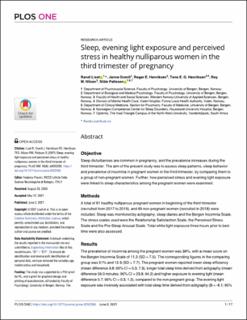| dc.contributor.author | Liset, Randi | |
| dc.contributor.author | Grønli, Janne | |
| dc.contributor.author | Henriksen, Roger Ekeberg | |
| dc.contributor.author | Henriksen, Tone Elise Gjøtterud | |
| dc.contributor.author | Nilsen, Roy Miodini | |
| dc.contributor.author | Pallesen, Ståle | |
| dc.date.accessioned | 2021-08-12T07:01:41Z | |
| dc.date.available | 2021-08-12T07:01:41Z | |
| dc.date.created | 2021-06-11T15:02:04Z | |
| dc.date.issued | 2021 | |
| dc.identifier.issn | 1932-6203 | |
| dc.identifier.uri | https://hdl.handle.net/11250/2767441 | |
| dc.description.abstract | Objective
Sleep disturbances are common in pregnancy, and the prevalence increases during the third trimester. The aim of the present study was to assess sleep patterns, sleep behavior and prevalence of insomnia in pregnant women in the third trimester, by comparing them to a group of non-pregnant women. Further, how perceived stress and evening light exposure were linked to sleep characteristics among the pregnant women were examined.
Methods
A total of 61 healthy nulliparous pregnant women in beginning of the third trimester (recruited from 2017 to 2019), and 69 non-pregnant women (recruited in 2018) were included. Sleep was monitored by actigraphy, sleep diaries and the Bergen Insomnia Scale. The stress scales used were the Relationship Satisfaction Scale, the Perceived Stress Scale and the Pre-Sleep Arousal Scale. Total white light exposure three hours prior to bedtime were also assessed.
Results
The prevalence of insomnia among the pregnant women was 38%, with a mean score on the Bergen Insomnia Scale of 11.2 (SD = 7.5). The corresponding figures in the comparing group was 51% and 12.3 (SD = 7.7). The pregnant women reported lower sleep efficiency (mean difference 3.8; 95% CI = 0.3, 7.3), longer total sleep time derived from actigraphy (mean difference 59.0 minutes; 95% CI = 23.8, 94.2) and higher exposure to evening light (mean difference 0.7; 95% CI = 0.3, 1.2), compared to the non-pregnant group. The evening light exposure was inversely associated with total sleep time derived from actigraphy (B = -8.1; 95% CI = -14.7, -1.5), and an earlier midpoint of sleep (B = -10.3, 95% CI = -14.7, -5.9). Perceived stressors were unrelated to self-reported and actigraphy assessed sleep.
Conclusion
In healthy pregnant participants sleep in the third trimester was preserved quite well. Even so, the data suggest that evening light exposure was related to shorter sleep duration among pregnant women. | en_US |
| dc.language.iso | eng | en_US |
| dc.publisher | Public Library of Science | en_US |
| dc.rights | Navngivelse 4.0 Internasjonal | * |
| dc.rights.uri | http://creativecommons.org/licenses/by/4.0/deed.no | * |
| dc.title | Sleep, evening light exposure and perceived stress in healthy nulliparous women in the third trimester of pregnancy | en_US |
| dc.type | Journal article | en_US |
| dc.type | Peer reviewed | en_US |
| dc.description.version | publishedVersion | en_US |
| dc.rights.holder | Copyright 2021 Liset et al. | en_US |
| dc.source.articlenumber | e0252285 | en_US |
| cristin.ispublished | true | |
| cristin.fulltext | original | |
| cristin.qualitycode | 1 | |
| dc.identifier.doi | 10.1371/journal.pone.0252285 | |
| dc.identifier.cristin | 1915326 | |
| dc.source.journal | PLOS ONE | en_US |
| dc.identifier.citation | PLOS ONE. 2021, 16 (6), e0252285. | en_US |
| dc.source.volume | 16 | en_US |
| dc.source.issue | 6 | en_US |

